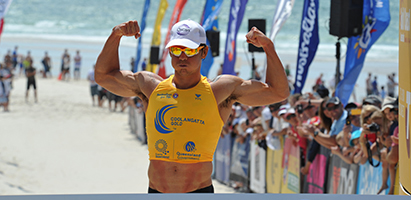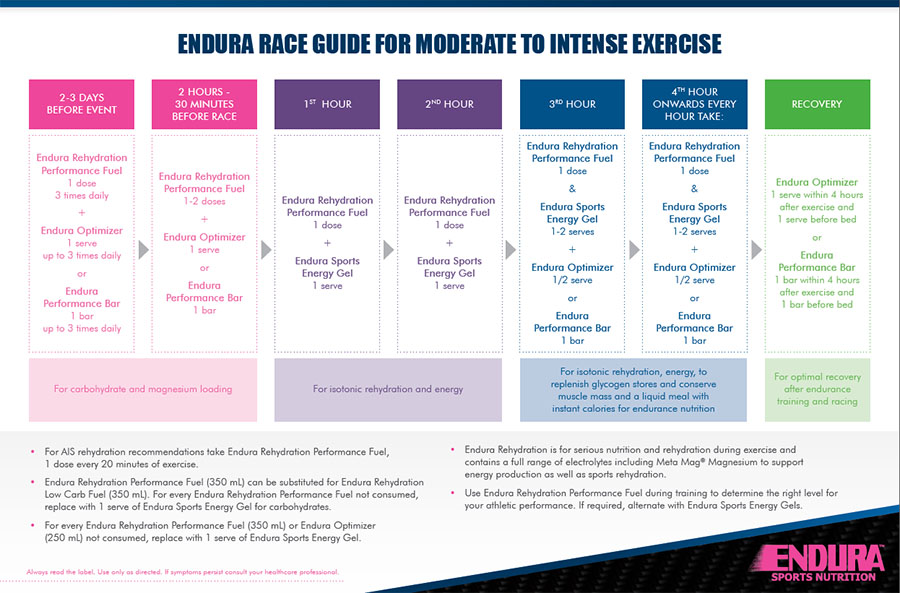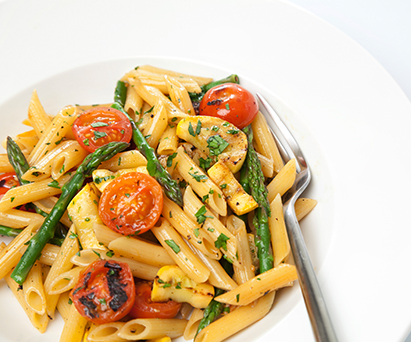
Endura Sports Nutrition represents a balanced blend of athletic intuition and cutting-edge science, providing practical tools to augment your performance. As good as Endura Sports Nutrition products are though, if you don’t know how to utilise them, their potential to help you won’t be maximised. While it is important to know how Endura Sports Nutrition products work, and what sets them apart from other options, it is even more vital to know the best way to use the Endura range for race preparation, both during events and for optimal recovery.
Pre-Race Loading Simplified
Your body has a limited amount of storage space for carbohydrates, magnesium and electrolytes. Therefore it is essential that you fill those stores ‘to the brim’ in the days leading up to a race to provide the maximum amount of fuel for the long haul. Carbohydrates are stored as glycogen in the liver and muscles, which can be readily converted to glucose for energy when required. Magnesium is needed to support muscle function, energy production and to help prevent cramps.1 Failing to load up effectively prior to the race can limit your endurance and performance capacity,2 and may leave you trailing the field.
Endura Optimizer and Endura Rehydration Performance Fuel are suitable for pre-race carbohydrate and magnesium loading, together providing a blend of carbs, magnesium and electrolytes. Follow the pre-race loading protocols below to optimise your results:
Pre-race loading

- Endura Rehydration Performance Fuel - mix 1 level scoop with 200 mL of water, 3 times per day for three days prior to your event.
- Endura Optimizer - mix 4 level scoops with 500 mL of water, up to 3 times per day for three days prior to your event.
On race day
- Endura Rehydration Performance Fuel - mix 1 to 2 level scoops into 350 mL to 700 mL of water and take 30 minutes prior to the race start.
- Endura Optimizer - mix 4 level scoops with 500 mL of water and consume within 2 hours to 30 minutes before the start of the race.
Consuming carbohydrates, whether from specifically designed supplements or carb-rich foods, is required to fill your glycogen stores,3 with the above protocol (when consuming all of the doses) providing more than 240 g of carbohydrate fuel for you each day. In addition, the amount of magnesium and electrolytes obtained from Endura Rehydration Performance Fuel and Endura Optimizer will help satisfy your body’s electrolyte requirements. Remember, if you want to nail your pre-race carbohydrate and magnesium loading, use Endura Sports Nutrition.
Endura for the short haul

When engaging in short to medium distance endurance events (two hours or less), the two key things that you must provide your body with are energy (carbohydrates) and hydration (water and electrolytes). Failing to provide your body’s essential requirements can result in poor performance. Within approximately 30 to 60 minutes of intensive exercise, not only does your body start to eat away at your glycogen (energy stores),4 but the effects of dehydration may begin to set in.5
Therefore, it is key for you to consume carbohydrates, water and electrolytes every 20 to 30 minutes during the race to provide energy, preserve glycogen, maintain hydration and avoid ‘hitting the wall’.
Your body requires 30 g to 60 g of carbohydrates per hour of short distance endurance exercise to maintain optimal ability. Endura Rehydration Performance Fuel provides 20 g of carbohydrates per dose along with high absorption key electrolytes. Endura Sports Energy Gels provide 26 g of carbs, an ample amount to meet your body’s requirements during the race, in a convenient, delicious form. To help keep you at your peak during an event that lasts less than two hours, follow these guidelines:
For short distance endurance events (less than two hours) use the following protocol:
- Endura Rehydration Performance Fuel - mix 1 level scoop every hour with 350 mL of water (you can replace Performance Fuel with a dose of Endura Rehydration Low Carb Fuel and an Endura Gel if you prefer to separate your carbs and electrolytes)
- Endura Sports Energy Gels - 1 serve every hour with 250 mL to 300 mL of water
Endura Sports Energy Gels and Endura Rehydration Performance Fuel are tools to help you reach your sporting potential during a short to medium endurance event.
Endura for the long haul
Once endurance events pass the two hour mark there is a seemingly subtle, but very important difference in the nutritional support that your body requires to maintain maximum speed. After two hours your body starts to break down muscle tissue in its search for energy to keep up with the punishing pace you are fighting to maintain. Therefore, it becomes important to consume a small amount of an easily digested form of protein to conserve muscle mass and maintain your performance. Endura Optimizer contains hydrolysed whey protein isolate, an easily absorbed, pre-digested protein, as well as both fast- and slow-releasing carbs, along with key electrolytes, making it a great nutritional addition once you hit the two-hour mark of a race.
For longer races, it is beneficial to consume between 60 g to 90 g of carbohydrates each hour;6 because the longer that you are racing, the greater your requirement for energy. By taking in more carbs each hour (even from the start of the race) you are able to stretch your glycogen stores out longer, and therefore go further, faster.
For long distance endurance events (greater than two hours) use the following protocol:
- Endura Rehydration Performance Fuel - mix 1 level scoop every hour with 350 mL of water
- Endura Sports Energy Gels - 1 to 2 serves every hour with 300 mL to 600 mL of water
- Endura Optimizer - from the two hour mark of the race, use ½ serve (2 level scoops) every hour with 250 mL of water
Use Endura Sports Nutrition products to optimise your performance, beat your times, and remain ahead of the pack every race!
The Endura Race Guide is a simple to follow, step-by-step guideline, showing you how to take best advantage of the Endura Sports Nutrition range for your endurance events. It covers everything from pre-race loading, to post-race recovery, and provides recommendations as to which Endura Sports Nutrition products work best for each situation. The Endura Race Guide is a valuable tool to utilise, but bear in mind, it is a guide, and isn’t intended to be strictly followed every time. Everyone has individual sports nutrition needs, therefore one guide cannot be perfect for everyone. The best way to use the Endura Race Guide is to try out the guidelines during training, then make minor amendments each training session until you find the formula that supports your endurance needs. For example, you might need a little more, or a little less carbohydrates than the Endura Race Guide suggests; or you may prefer to use Endura Optimizer immediately after completing your training session on top of what the guide recommends. The important things to remember are:
- Use the Endura Race Guide as a guide, not as strict instructions
- Practice your regime during training sessions, don’t try it out for the first time during a race
- Figure out what your body responds best to and stick with it on race day
By using the Endura Race Guide you can be confident that you are covering your body’s basic nutrition needs. Play around with it, practice using it, and once you find what works best for you, beat your competition with it!
Fluid loss during exercise can range from 0.3 L - 2.4 L per hour depending on various factors, such as intensity of exercise and environmental conditions. Fluid loss of just 2% (e.g. by sweating) can impact athletic performance, which for the average person (70kg to 80 kg) would be a loss of just 1.4 L - 1.6 L. This is likely to occur within an hour of exercise in hot, humid conditions.
To pre-load glycogen stores prior to a competition, consume 10 g to 12 g per kg/body weight of carbs each day for two to three days.
References:
- Bohl H et al. Magnesium and exercise. Critl Rev Food Sci Nutr; 2002;42:6
- Burke LM et al. Carbohydrates for training and competition. J Sports Sci, 2011 Jun 8:1-11
- Burke LM et al. Carbohydrates for training and competition. J Sports Sci, 2011 Jun 8:1-11
- Gollnick PD et al. Selective glycogen depletion pattern in human muscle fibres after exercise of varying intensity and at varying pedalling rates. J Physiol. 1974; 241; 45-57
- Rodriguez NR, DiMarco NM, Langley S; American Dietetic Association; Dietetians of Canada; American College of Sports Medicine. Position of the American Dietetic Association, Dietitians of Canada, and the American College of Sports Medicine: Nutrition and athletic performance. J Am Diet Assoc. 2009 Mar;109(3):509-27.
- Burke LM et al. Carbohydrates for training and competition. J Sports Sci, 2011 Jun 8:1-11
Always read the label. Use only as directed. If symptoms persist consult your healthcare professional.